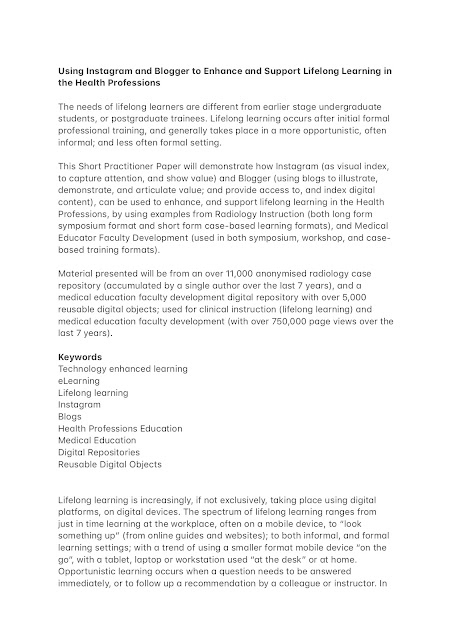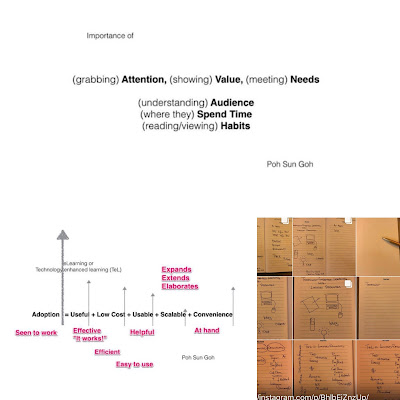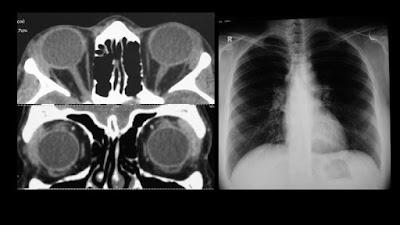or
see also
Upcoming
https://learningheadandneckradiology.blogspot.sg/2016/06/imaging-in-thyroid-eye-disease-role-of.html
TAPS Editorial Board Meeting, Thursday 1st March 2018
16th APMEC 2019 Organising Committee Meeting, Tuesday 6th March 2018, 3pm to 4pm
McNabb, J., Pawlyshyn, N. Northeastern University Online. 2014. Defining-Scholarship-with-Boyers-Four-Areas-of-Scholarship-Explored-and-the-New-DigitalScholarship-A-Faculty-Conversation.pdf
"Enable all forms of scholarship: Discovery, Integration, Application, Teaching, Engagement and Digital."
above tip from
"To the extent that this practical knowledge can be more systematically produced, captured, and disseminated (i.e., made more scholarly) practitioners can accelerate the value that CME/CPD can contribute to health care."
above quote from
Olson CA. On the Need for Scholarly Practitioners in CPD. JOURNAL OF CONTINUING EDUCATION IN THE HEALTH PROFESSIONS, 31(3):137–139, 2011.
AMEE/MEW Webinar 138: Conducting Research in Faculty Development by David M Irby Patricia S. O'Sullivan
(Invited ACGME Faculty Development talk for O and G department, Monday, 5 March 2018 @ 0730 to 0830am)
Interactive Education: Impact of the Internet on Learning & Teaching (Professor Hossein Arsham)
The future impact of the Internet on higher education: Experts expect more-efficient collaborative environments and new grading schemes; they worry about massive online courses, the shift away from on-campus life (2012) Pew Research Center’s Internet & American Life Project.
Norman, G. (2012). Medical education: past, present and future. Perspectives on Medical Education, 1(1), 6–14. http://doi.org/10.1007/s40037-012-0002-7
"Understanding basic theory using a few illustrative examples. Mastering a topic by exposure to and experience with many examples
Typical examples or real-life scenarios can be used to illustrate theory, and help students understand fundamental principles. Mastering a topic usually requires exposure to and experience with many examples, both typical and atypical, common to uncommon including subtle manifestations of a phenomenon. The traditional method of doing this is via a long apprenticeship, or many years of practice with feedback and experience. A digital collection of educational scenarios and cases can support and potentially shorten this educational and training process. Particularly if a systematic attempt is made to collect and curate a comprehensive collection of all possible educational scenarios and case-based examples, across the whole spectrum of professional practice. Online access to key elements, parts of and whole sections of these learning cases; used by students with guidance by instructors under a deliberate practice and mastery training framework, can potentially accelerate the educational process, and deepen learning."
above from
Goh, P.S. A series of reflections on eLearning, traditional and blended learning. MedEdPublish. 2016 Oct; 5(3), Paper No:19. Epub 2016 Oct 14. http://dx.doi.org/10.15694/mep.2016.000105
Goh P, Learning Analytics in Medical Education , MedEdPublish, 2017, 6, [2], 5, doi:https://doi.org/10.15694/mep.2017.000067
Matt M. Cirigliano, Charlie Guthrie, Martin V. Pusic, Anna T. Cianciolo, Jennifer E. Lim-Dunham, Anderson Spickard III & Valerie Terry (2017) “Yes, and …” Exploring the Future of Learning Analytics in Medical Education, Teaching and Learning in Medicine, 29:4, 368-372, DOI: 10.1080/10401334.2017.1384731
Chan, T., Sebok-Syer, S., Thoma, B., Wise, A., Sherbino, J. and Pusic, M. Learning Analytics in Medical Education Assessment: The Past, The Present and The Future. Education and Training, April 2018. https://onlinelibrary.wiley.com/doi/abs/10.1002/aet2.10087
Procedia - Social and Behavioral Sciences
Volume 204, 24 August 2015, Pages 282-289
Journal of the College of Physicians and Surgeons Pakistan 2015, Vol. 25 (4): 292-293
see also
Goh, P.S. eLearning in Medical Education - Costs and Value Add. The Asia Pacific Scholar (TAPS). Published online: 2 May, TAPS 2018, 3(2), 58-60. DOI: https://doi.org/10.29060/TAPS.2018-3-2/PV1073
Meeting, DDI, NUH, Tuesday morning, 22 May 2018
and
Unit 7: 11 June 2018 to 29 June 2018
Unit 1: 2 July to 20 July 2018
see also
Poh-Sun Goh
Learning analytics (LA) offers teachers, students and administrators insights into the educational and training process in medical education, from participation, through engagement, toward intermediate and final outcomes of education and training. The LA process can be applied in both traditional, blended, and eLearning (technology enhanced learning or TEL environments), with TEL offering the possibility of real time (near real time) data visualisation and analysis (Goh, 2017).
Digital teaching to promote learning, showcases "what we teach with, and assess on" (Goh, 2016). As educational scholars, we can use Digital Scholarship to demonstrate not only the variety, breadth and depth of our educational activities; but also actively engage in educational scholarship, by making full use of digital tools, platforms, data and analytics.
The use, and integration of digital content, tools, platforms and processes into traditional teaching and training in medical education offers us the potential to go beyond the “scholarship of discovery, application, integration and teaching” (Glassick, 2000) to include “digital scholarship” (Scanlon, 2017)). This allows us to not only document, make accessible and visible the education and training process through a learning analytics process; but to also combine and use the digital material, as well as metrics of participation, engagement, as well as intermediate and final outcomes of our digital teaching and training process as the basis for educational scholarship, for peer review, critique and for others to build on and modify (Goh, 2017).
As we increasingly rely on TEL, which not only expands the scale and reach of our educational and training efforts, we gain both data and visibility of the online and mobile learning space, which is amenable to data visualisation and analysis, both human and artificial intelligence (AI) mediated. Our mobile and online learning platforms, online connected sensors, and AI driven software and robotic teaching and training, and well as health care service delivery tools offer the possibility of reproducibly delivering high quality service, layered with the “human touch”, with both AI interfaces and human carers. Just as we blend technology, and face to face learning and training paradigms, we can blend efficiency and service effectiveness of AI and robotics, with the intangibles of human empathy, caring, customisation and personalisation. Our approach to thriving in an AI and technology mediated landscape is to become “more human”, emphasising the richness of the human and interpersonal experience (Bess, 2018), in both healthcare and transformation of education, for example by going beyond Bloom’s taxonomy, to augment this for an AI mediated world (Durfee, 2018), similar to how we augment healthcare increasingly with AI (Williams, 2018).
References:
Bess, M. (2018) https://www.vox.com/technology/2018/2/23/16992816/facebook-twitter-tech-artificial-intelligence-crispr
Durfee, A.(2018) http://www.gettingsmart.com/2018/01/the-value-of-the-human-in-an-ai-world/
Goh PS, The value and impact of eLearning or Technology enhanced learning from one perspective of a Digital Scholar, MedEdPublish, 2016, 5, [3], 31, doi:https://doi.org/10.15694/mep.2016.000117
https://www.mededpublish.org/manuscripts/613/v1
Goh, P.S. Learning Analytics in Medical Education. MedEdPublish. 2017 Apr; 6(2), Paper No:5. Epub 2017 Apr 4. https://doi.org/10.15694/mep.2017.000067
Glassick CE. Boyer's expanded definitions of scholarship, the standards for
assessing scholarship, and the elusiveness of the scholarship of teaching. Acad
Med. 2000 Sep;75(9):877-80.
https://www.ncbi.nlm.nih.gov/pubmed/10995607
Scanlon, E. Concepts and Challenges in Digital Scholarship
Front. Digit. Humanit., 27 July 2017 | https://doi.org/10.3389/fdigh.2017.00015
Williams, B. (2018) http://usblogs.pwc.com/emerging-technology/ai-in-healthcare/
https://www.cnbc.com/2018/06/13/apples-ai-strategy-devices-not-cloud.html
Learning Analytics and Digital Scholarship
Poh-Sun Goh
Learning analytics (LA) offers teachers, students and administrators insights into the educational and training process in medical education, from participation, through engagement, toward intermediate and final outcomes of education and training. The LA process can be applied in both traditional, blended, and eLearning (technology enhanced learning or TEL environments), with TEL offering the possibility of real time (near real time) data visualisation and analysis (Goh, 2017).
Digital teaching to promote learning, showcases "what we teach with, and assess on" (Goh, 2016). As educational scholars, we can use Digital Scholarship to demonstrate not only the variety, breadth and depth of our educational activities; but also actively engage in educational scholarship, by making full use of digital tools, platforms, data and analytics.
The use, and integration of digital content, tools, platforms and processes into traditional teaching and training in medical education offers us the potential to go beyond the “scholarship of discovery, application, integration and teaching” (Glassick, 2000) to include “digital scholarship” (Scanlon, 2017)). This allows us to not only document, make accessible and visible the education and training process through a learning analytics process; but to also combine and use the digital material, as well as metrics of participation, engagement, as well as intermediate and final outcomes of our digital teaching and training process as the basis for educational scholarship, for peer review, critique and for others to build on and modify (Goh, 2017).
As we increasingly rely on TEL, which not only expands the scale and reach of our educational and training efforts, we gain both data and visibility of the online and mobile learning space, which is amenable to data visualisation and analysis, both human and artificial intelligence (AI) mediated. Our mobile and online learning platforms, online connected sensors, and AI driven software and robotic teaching and training, and well as health care service delivery tools offer the possibility of reproducibly delivering high quality service, layered with the “human touch”, with both AI interfaces and human carers. Just as we blend technology, and face to face learning and training paradigms, we can blend efficiency and service effectiveness of AI and robotics, with the intangibles of human empathy, caring, customisation and personalisation. Our approach to thriving in an AI and technology mediated landscape is to become “more human”, emphasising the richness of the human and interpersonal experience (Bess, 2018), in both healthcare and transformation of education, for example by going beyond Bloom’s taxonomy, to augment this for an AI mediated world (Durfee, 2018), similar to how we augment healthcare increasingly with AI (Williams, 2018).
References:
Bess, M. (2018) https://www.vox.com/technology/2018/2/23/16992816/facebook-twitter-tech-artificial-intelligence-crispr
Goh PS, The value and impact of eLearning or Technology enhanced learning from one perspective of a Digital Scholar, MedEdPublish, 2016, 5, [3], 31, doi:https://doi.org/10.15694/mep.2016.000117
Goh, P.S. Learning Analytics in Medical Education. MedEdPublish. 2017 Apr; 6(2), Paper No:5. Epub 2017 Apr 4. https://doi.org/10.15694/mep.2017.000067
Glassick CE. Boyer's expanded definitions of scholarship, the standards for
assessing scholarship, and the elusiveness of the scholarship of teaching. Acad
Med. 2000 Sep;75(9):877-80.
Scanlon, E. Concepts and Challenges in Digital Scholarship
Front. Digit. Humanit., 27 July 2017 | https://doi.org/10.3389/fdigh.2017.00015
Williams, B. (2018) http://usblogs.pwc.com/emerging-technology/ai-in-healthcare/
Norman, G. (2012). Medical education: past, present and future. Perspectives on Medical Education, 1(1), 6–14. http://doi.org/10.1007/s40037-012-0002-7
"Understanding basic theory using a few illustrative examples. Mastering a topic by exposure to and experience with many examples
Typical examples or real-life scenarios can be used to illustrate theory, and help students understand fundamental principles. Mastering a topic usually requires exposure to and experience with many examples, both typical and atypical, common to uncommon including subtle manifestations of a phenomenon. The traditional method of doing this is via a long apprenticeship, or many years of practice with feedback and experience. A digital collection of educational scenarios and cases can support and potentially shorten this educational and training process. Particularly if a systematic attempt is made to collect and curate a comprehensive collection of all possible educational scenarios and case-based examples, across the whole spectrum of professional practice. Online access to key elements, parts of and whole sections of these learning cases; used by students with guidance by instructors under a deliberate practice and mastery training framework, can potentially accelerate the educational process, and deepen learning."
above from
Goh, P.S. A series of reflections on eLearning, traditional and blended learning. MedEdPublish. 2016 Oct; 5(3), Paper No:19. Epub 2016 Oct 14. http://dx.doi.org/10.15694/mep.2016.000105
Goh P, Learning Analytics in Medical Education , MedEdPublish, 2017, 6, [2], 5, doi:https://doi.org/10.15694/mep.2017.000067
Matt M. Cirigliano, Charlie Guthrie, Martin V. Pusic, Anna T. Cianciolo, Jennifer E. Lim-Dunham, Anderson Spickard III & Valerie Terry (2017) “Yes, and …” Exploring the Future of Learning Analytics in Medical Education, Teaching and Learning in Medicine, 29:4, 368-372, DOI: 10.1080/10401334.2017.1384731
Chan, T., Sebok-Syer, S., Thoma, B., Wise, A., Sherbino, J. and Pusic, M. Learning Analytics in Medical Education Assessment: The Past, The Present and The Future. Education and Training, April 2018. https://onlinelibrary.wiley.com/doi/abs/10.1002/aet2.10087

Instagram - for grabbing attention, showing value
Slideshare - for access, analytics (views, downloads, clipping)
Blogger - for access, analytics, as digital repository
Goh, P.S. Using a blog as an integrated eLearning tool and platform. Med Teach. 2016 Jun;38(6):628-9. Epub 2015 Nov 11.
Padlet - as online bulletin board, for access
Goh, P.S., Sandars, J. An innovative approach to digitally flip the classroom by using an online "graffiti wall" with a blog. Med Teach. 2016 Aug;38(8):858. Epub 2016 Jul 14.
Role of Instagram (-like Content) in eLearning, eTeaching, Digital Research and Scholarship from Poh-Sun Goh
see more at
see more at
Upcoming book chapters in
above screenshot from
see more at
Annual Academic Meeting, Taipei, November 17, 2018
http://www.tssh.org.tw/
Dear TSSH participants,
The morning session will review the literature and pedagogy of VR and AR. Modelled after the presentation I gave at the symposium at AMEE 2018
The afternoon session will move on to take the next step. Described in the rather long title of the afternoon session - "Starting the journey to develop and use material for VR and AR in Medical Education: Without funding, by using what is at hand, a design thinking and innovative blueprinting process, anchored by sound pedagogy and a market orientation to the educational needs of the user"
https://www.slideshare.net/dnrgohps/starting-the-journey-to-develop-and-use-material-for-vr-and-ar-in-medical-education-120058318
https://www.slideshare.net/dnrgohps/starting-the-journey-to-develop-and-use-material-for-vr-and-ar-in-medical-education-120058318
Both morning and afternoon presentations will be very interactive with the audience, who are requested to bring an internet enabled mobile device/tablet/laptop to both morning and afternoon sessions. I will be live presenting directly off the internet, have requested that the venue have high bandwidth fast internet for both the presenter (myself) on a presenting laptop with wired mouse on podium, as well as for the audience.
I look forward to meeting all participants at the TSSH conference, and many interesting discussions.
See you at the sessions!
Goh Poh Sun
吴宝山
see more at
click on tile above to access website






































































































































































































No comments:
Post a Comment
Note: only a member of this blog may post a comment.